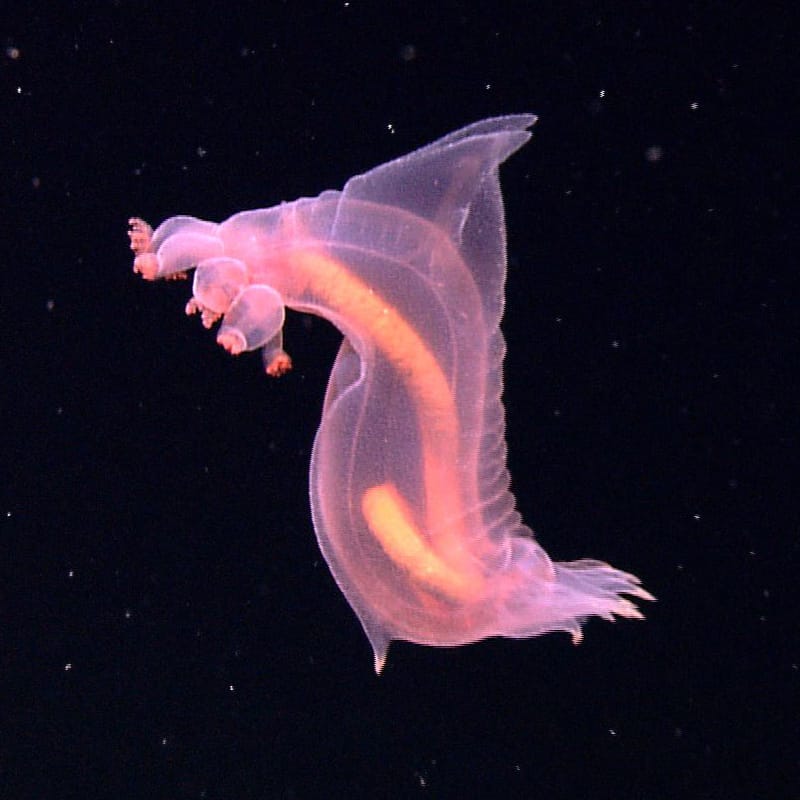In the depths of the Pacific Ocean, two miles below sea level, scientists made a puzzling discovery. They recovered what appeared to be a golden ‘egg’ from the seafloor on August 30th, 2023. This discovery was made during an expedition to map parts of the unexplored seafloor off the coast of Alaska. Scientists have yet to identify the mysterious object but speculate it may be an egg case of an invertebrate animal or the remains of a marine sponge.
Expedition coordinator Sam Candio said, “We still are not able to identify it beyond the fact that it is biological in origin”. The orb was removed from its rock and collected using a gentle suction device for further examination.
The golden egg is incredibly unique and left researchers stunned. According to the National Oceanic and Atmospheric Administration (NOAA), the egg appears shiny and gold in color. It consists of a soft, skin-like material. There is also a gaping hole on the side of the orb, but its cause is unknown. Scientists suggest it may be a result of an encounter with another sea creature, or something trying to exit or enter the ‘egg’.
The researchers who found the egg are members of the Seascape Alaska 5 expedition. Their fascinating research is aboard the NOAA Okeanos Explorer ship in the frigid waters of the Gulf of Alaska. The team uses remotely operated vehicles and multibeam sonar at depths ranging between 200 and 6,000 meters to explore deep-sea habitats. You can watch livestreams of their dives daily from August 24th through September 15th, 2023, or later on YouTube.
The golden egg was an exciting find that highlights the incredible diversity of life yet to be uncovered in these intense deepwater ecosystems.
What is the Seafloor?
The seafloor, or ocean floor, is a vast and mysterious expanse covering more than two-thirds of the Earth’s surface. Approximately only 20% of the seafloor has been mapped. It is a dynamic and complex environment with a range of topographic features and geology. At first glance, the seafloor may appear as a uniform abyss. In reality, it is a shifting landscape shaped by a variety of geological processes.
One of the most prominent features of the seafloor is the Mid-Ocean Ridge system, an underwater mountain range that stretches for thousands of miles and winds its way through all the world’s oceans. This immense mountain chain is the result of tectonic plate boundaries diverging. Molten rock rises from the Earth’s mantle to create new crust, pushing the existing crust apart. This process not only gives rise to the Mid-Ocean Ridges but also leads to the formation of deep ocean basins and rift valleys. These geologic formations are home to a multitude of unique ecosystems, including hydrothermal vent communities that thrive in extreme conditions, fueled by hot, mineral-rich fluids seeping from the seafloor.
The geology of the seafloor is incredibly diverse, with various sediment types, rock formations, and mineral deposits. Sediments on the seafloor can range from fine clay particles to coarser sands and gravels. These substances accumulate over time due to the erosion of continental landmasses and the settling of biological remains. Beneath these sediments lie various types of oceanic crust, primarily consisting of basaltic rock. Basaltic rock formation occurs through volcanic activity along the Mid-Ocean Ridges. Additionally, the seafloor is also rich in valuable mineral resources. Polymetallic nodules, hydrothermal sulfides, and massive sulfide deposits have garnered significant attention for their economic potential.
What Lives in the Deep Ocean?
Deep-sea creatures are some of the most intriguing and enigmatic life forms on our planet. In fact, scientists estimate that 91% of marine species have yet to be classified. These unique organisms thrive in the dark and extreme conditions of the ocean’s abyss. Many inhabit the seafloor, a world of immense pressure, near-freezing temperatures, and a complete absence of sunlight. Despite these challenges, a remarkable array of life has adapted to this environment.

This is a spectacular image of a benthopelagic sea cucumber swimming in the near-freezing waters of the abyss. The image is from the Little
Hercules
ROV at 3,205 meters depth on “Site K,” taken during the INDEX SATAL 2010 expedition.
©NOAA Okeanos Explorer, Public domain, via Wikimedia Commons – License
One of the most well-known deep-sea creatures that call the seafloor home is the abyssal polychaete worm. These elongated, segmented worms burrow into the soft sediments of the seafloor and create intricate tunnels. They feed on detritus and organic matter that rains down from the surface, making the most of the scarce nutrients that reach these depths. In addition to polychaetes, various species of sea cucumbers and isopods commonly live on the seafloor. They scavenge for food and break down decaying matter.
Hydrothermal Vents
One of the most fascinating aspects of seafloor ecosystems is the presence of hydrothermal vent communities. These extreme environments exist along mid-ocean ridges, where superheated water rich in minerals and chemicals spews out from the seafloor. Deep-sea creatures like giant tube worms, vent mussels, and vent crabs have evolved to thrive in this harsh setting. They rely on chemosynthetic bacteria within their bodies to convert the chemicals emitted from the hydrothermal vents into energy, forming the base of a unique food chain independent of sunlight. This adaptation showcases the incredible diversity and adaptability of life in the deep sea, where organisms have found ingenious ways to obtain nutrients in one of the Earth’s most challenging environments.
The newly discovered golden egg is the latest clue left by one of the many mysterious organisms in the deep ocean.
The photo featured at the top of this post is © Angelo Giampiccolo/Shutterstock.com
Thank you for reading! Have some feedback for us? Contact the AZ Animals editorial team.







